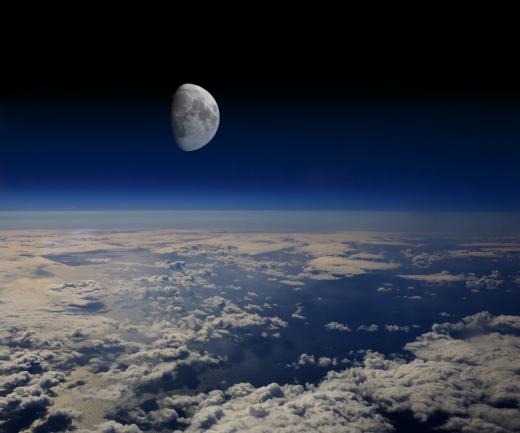What is a Lunar Month?
 Mary McMahon
Mary McMahon
A lunar month or synodic month is a period of time measured in relationship to the movement of the moon. There are actually several different ways to calculate a lunar month, which means that it can vary in length depending on which system is used. Several religions use these months to establish their calendars, and the lunar month is also sometimes seen used to mark time in a pregnancy.
One common method used to determine a lunar month is to look at the period between syzygy, when the moon and sun are lined up to make a new moon or a full moon. In this case, the synodic month as it is also known runs from new moon to new moon or from full moon to full moon. This lunar month lasts about 29 days, 12 hours, and 44 minutes. Other modes of calculation use the moon's orbital period, in a type of lunar month sometimes called a sidereal month.

Lunar months can also be measured by tracking the moon as it moves from perigee to perigee, when it is closest to the Earth, or when the moon returns to one of the two nodes in its orbit which intersect with Earth's orbit. These different calculation techniques used to determine the lunar month can yield months which last between 27 and 29 days.
The problem with the lunar month is that if lunar months are used to calculate time, over an extended period of time, the calendar will start to be off. Eventually, the lunar calendar won't actually map up with the phases of the moon. As a result, lunar calendars must be periodically adjusted to bring them back up to speed and to keep them on track with the actual movements of the moon. Among faiths which use lunar months to mark time, special calendars are issued annually so that people can keep up with the lunar months.

As it is, the Gregorian calendar used internationally is also off a bit, which is why leap years must be inserted to keep pace. Periodically, leap seconds are also added. This is because orbits are not perfectly precise, and small variations can translate into huge calendar miscalculations over the course of time. In nations where numerous people use the lunar calendar, dates are sometimes given in both calendar systems for convenience, and converters are also readily available.
AS FEATURED ON:
AS FEATURED ON:












Discussion Comments
Like pregnancy, many women also find that their menstrual cycles end up flowing on a lunar month calendar rather than on a more Gregorian one. While my own has always been more irregular, I do have a who swears that she is part werewolf- she always menstruates during the the full lunar phase, and stops shortly after the moon starts waning.
When looking at how different the lunar calendar and other calendars, such as the Gregorian, can vary, just imagine the concept of a Blue Moon. Usually only once a year or less, a Blue Moon is a calendar month in which there are two separate full moon periods- somehow, the lunar cycle both ended and then went through an entire cycle in the same 30- or 31- day period.
Post your comments